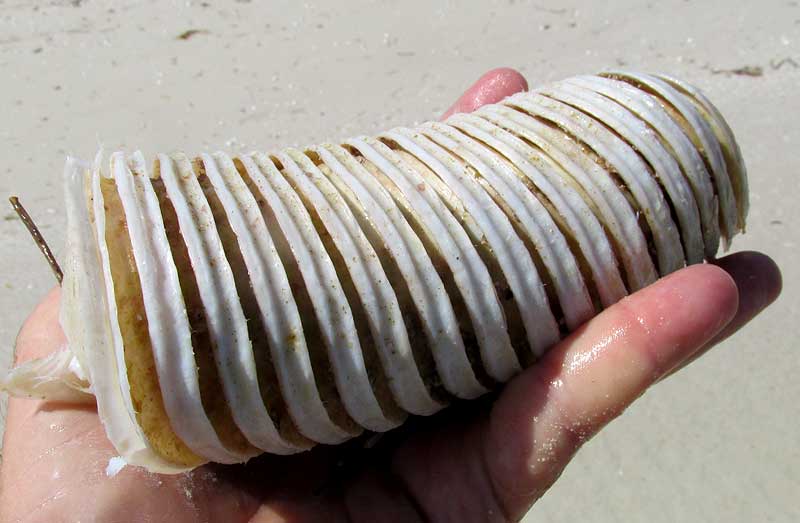Excerpts from Jim Conrad's
Naturalist Newsletter

from the March 29, 2015 Newsletter issued from Río Lagartos, on the Yucatan Peninsula's northern coast (~N21.60°, ~W88.16°), Yucatán state, MÉXICO
CHANK EGG CASES
By now we've learned that seashell-producing, gastropod-type mollusks sometimes produce egg cases looking like papery wafers strung together in a line. We look at those of the Pear Whelk at www.backyardnature.net/n/14/141228bu.jpg.
Those of the Knobbed Whelk are at www.backyardnature.net/n/11/110515wk.jpg.
And of the Lightning Whelk at www.backyardnature.net/n/15/150222wl.jpg.
And the more ornate ones of the True Tulip at www.backyardnature.net/n/14/141214tu.jpg.
Despite such familiarity, the object that washed up this week on the Gulf of Mexico sand was so large and regularly formed that I doubted they were just another mollusk species' egg cases. That's the new discovery at the top of this page.
The wafer-like items were attached along one side to a woody-looking, splinter-like thing, as shown below:

Despite the size, the thing turned out to be yet another kind of strung-together egg cases of a seashell-producing, gastropod-type mollusk, this time that of the West Indian Chank, TURBINELLA ANGULATA. West Indian Chanks occur from the US's Florida Keys south through the Gulf of Mexico and the Caribbean to northern South America. Our egg cases are so large because West Indian Chanks can grow over a foot long (36cm).
West Indian Chanks live on a variety of subtidal and offshore mud, rock or sand beds, and mangrove lagoons vegetated with seagrass.
They're called chanks instead of whelks or tulips because they belong to a different mollusk family, the Turbinellidae, than the whelks' Buccinidae, or the tulips' Fasciolariidae.
The interesting name "chank" is a corruption of the name "shankha," which is applied to the Divine Conch or Sacred Conch, Turbinella pyrum, a closely related species from the Indian Ocean. Sometimes the word "chank" is used interchangeably with "conch," but that's sloppy talking.